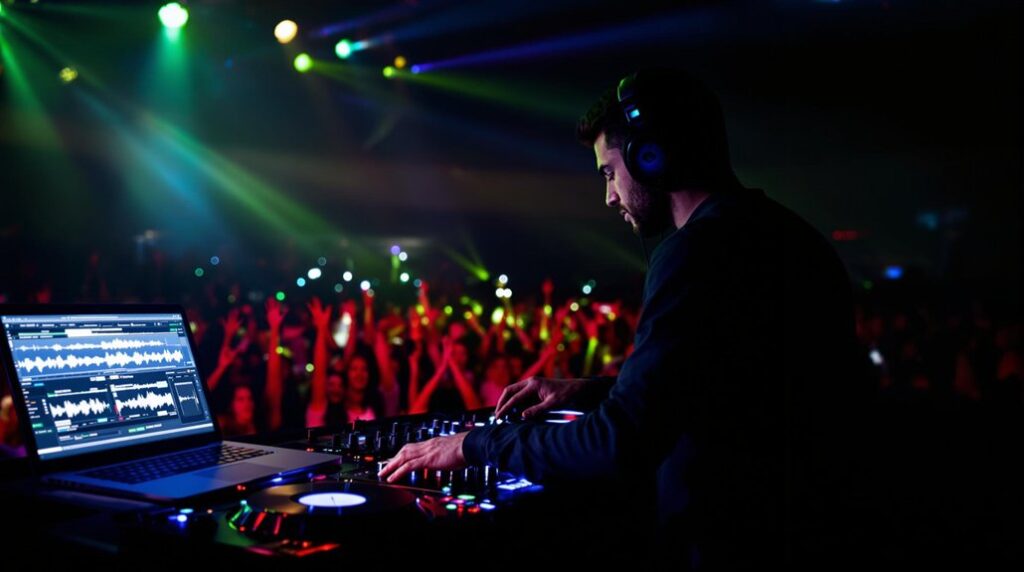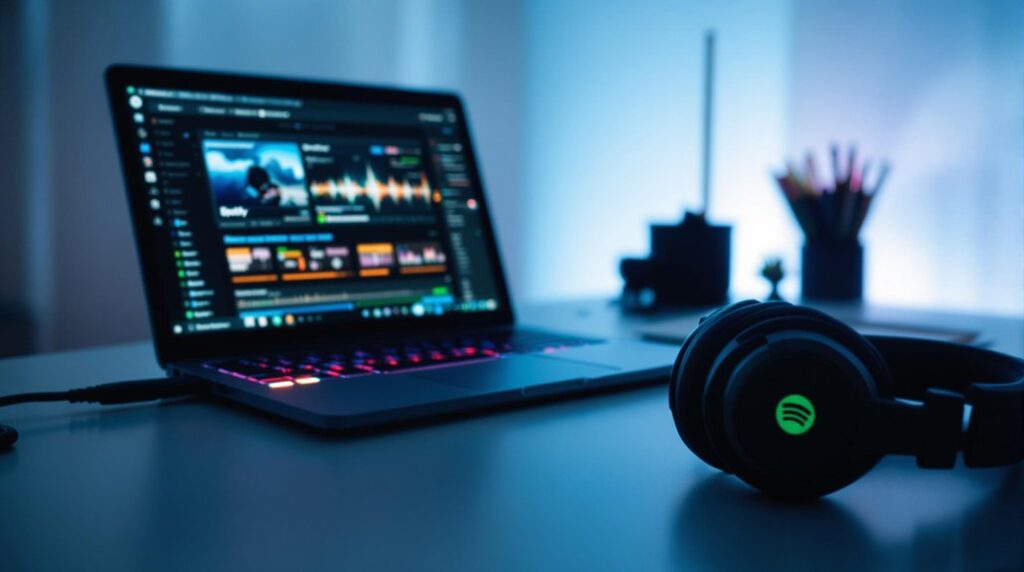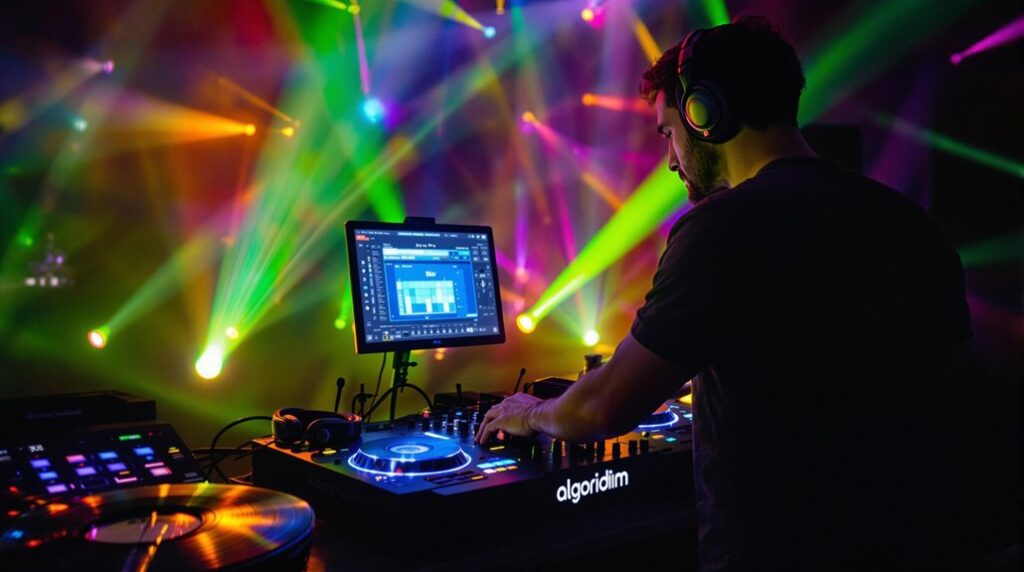Understanding DJ controllers is essential for any beginner aiming to navigate the DJ landscape. DJ controllers amalgamate traditional turntables and mixers into an efficient, single apparatus, interfacing with computers via USB to enable intricate track management through DJ software. They typically feature jog wheels for vinyl-like performance, performance pads for sample and cue triggering, and extensive EQ controls. Advanced models incorporate sophisticated effects and looping functionalities, enhancing dynamic set engagement. When selecting a controller, consider software compatibility, build quality, and core components like jog wheels and performance pads. Explore more to master the intricacies and boost your DJing prowess.
Key Takeaways
- DJ controllers combine turntables and mixers, connecting to computers via USB for seamless integration with DJ software.
- Essential features include jog wheels, performance pads, EQ controls, and built-in effects for dynamic performances.
- Entry-level models are user-friendly, portable, and often come bundled with essential DJ software.
- Ensure compatibility with popular DJ software like Serato DJ, Traktor Pro, and Virtual DJ.
- Metal-bodied controllers are preferred for their durability and reliability during frequent transport.
Overview of DJ Controllers
DJ controllers, the quintessential tools for modern disc jockeys, amalgamate the functionalities of traditional turntables and mixers into a single, streamlined device. These all-in-one units connect to computers via USB, integrating seamlessly with DJ software to manage music files, mix tracks, and access performance features.
The inherent portability and intuitive design of DJ controllers make them particularly advantageous for beginner setups, offering a cost-effective and user-friendly entry point into the domain of DJing.
There are various DJ controller types, each catering to different skill levels and performance requirements. Entry-level models, such as the Hercules DJ Control Inpulse 500 and Pioneer DDJ-200, are designed with novice DJs in mind, often bundled with essential DJ software to facilitate a smooth learning curve.
These beginner setups typically feature jog wheels for scratching, performance pads for triggering samples, EQ controls, and faders for manipulating volume and effects. Many of these controllers also come with built-in effects like echo and flanger, encouraging creative exploration during practice.
High-quality build and responsive controls are critical for both practice and live performances. The user-friendly interfaces of these controllers emphasize durability and performance, ensuring that even the most nascent DJs can develop their skills effectively.
Understanding these nuances is crucial for selecting the appropriate DJ controller to match one’s aspirations and technical requirements.
Key Features and Capabilities
Understanding the core features and capabilities of DJ controllers is imperative for selecting the right tool to enhance your DJing experience. DJ controllers seamlessly integrate the functionalities of mixers and turntables, enabling DJs to manipulate multiple tracks and adjust tempo with precision.
Central to these devices are the jog wheel functionality and performance pad usage. Jog wheels, essential for scratching and pitch bending, offer tactile control that simulates the vinyl experience, allowing for intricate track manipulation. For instance, the motorized jog wheels found in the Pioneer DJ XDJ-RX3 and Denon DJ Prime 4+ provide enhanced tactile feedback, making them a favorite among DJs who value a hands-on approach.
Performance pads, typically located below the jog wheels, facilitate the triggering of samples, cue points, and loops, thereby augmenting creative mixing possibilities. Essential controls such as EQ adjustments, volume faders, and crossfaders provide DJs with granular control over sound output, while advanced models incorporate effects and looping functionalities, enabling more dynamic and enriched performances.
The inclusion of bundled DJ software enhances user interaction by providing visual aids and simplifying the mixing process, making it easier to execute complex changes.
Additionally, the build quality of a DJ controller, often favoring metal over plastic, profoundly impacts its durability and performance reliability. Understanding these core features guarantees that both novice and professional DJs can make informed decisions, optimizing their performance potential.
Choosing a DJ Controller
Selecting the ideal DJ controller requires a nuanced understanding of both personal needs and technical specifications. When choosing a DJ controller, one must first consider controller compatibility with popular DJ software such as Serato DJ, Traktor Pro, or Virtual DJ. Seamless integration with these platforms can greatly enhance your mixing experience. Budget considerations are equally critical; entry-level controllers start around £79, while mid-range options range from £500 to £1,000. Establishing a budget aligned with your skill level and aspirations is essential.
Key attributes to seek in a DJ controller include jog wheels, performance pads, and EQ controls. These components are crucial for effective track mixing. Build quality is another important factor; opting for metal-bodied controllers over plastic ones can enhance durability and longevity, especially if frequent transport is anticipated. Additionally, some controllers come bundled with DJ software, offering a cost-effective starting point for beginners.
| Feature | Importance |
|---|---|
| Software Compatibility | Enhances integration with DJ software |
| Budget | Guides purchase decision based on skill |
| Essential Components | Jog wheels, performance pads, EQ controls |
| Build Quality | Metal bodies for durability |
| Bundled Software | Cost-effective for beginners |
Music Sourcing and Management
Effective music sourcing and management are essential for professional DJs, encompassing the acquisition of high-fidelity tracks from digital stores like Beatport and Juno Download, while maneuvering through the limitations of streaming services such as Spotify and TIDAL.
It’s vital to maintain a diverse selection of music to cater to different crowd preferences and event moods. A meticulously organized music library within DJ software greatly enhances performance efficiency, allowing seamless access to diverse genres and exclusive tracks from record pools like DJcity.
Regularly updating and managing your collection guarantees relevance and innovation, fostering a unique auditory experience for audiences.
Digital Stores and Formats
In the domain of professional DJing, sourcing and managing music from digital stores and formats is a cornerstone of crafting superior audio experiences. Leveraging digital music from reputable platforms like Beatport, Juno Download, and Traxsource is pivotal for any serious DJ. These digital stores offer tracks in lossless formats such as WAV and FLAC, guaranteeing an uncompromised quality that is essential for high-fidelity DJ mixes.
The strategic acquisition of music extends beyond mere download; it involves curating a diverse library that spans various genres and remains current with industry trends. Record pools like DJcity and BPM Supreme are invaluable resources, providing exclusive tracks and DJ-friendly edits that can give performers a competitive edge.
Ensuring a well-organized digital music library is critical for seamless performance, allowing quick access to tracks and facilitating smooth changes during live sets. Prioritizing high-quality, professionally sourced music not only enhances the auditory experience but also aligns with the standards expected in professional environments.
Streaming Services Insights
Harnessing the potential of streaming services such as Spotify, Apple Music, and TIDAL has revolutionized music sourcing and management for modern DJs. These platforms offer a vast library of tracks, providing unparalleled streaming advantages by enabling DJs to discover and curate diverse playlists with ease.
However, despite the convenience, the licensing challenges associated with these services pose significant limitations. Specifically, the commercial use of tracks in DJ software is often restricted, requiring DJs to seek alternative sources for performance-ready music.
High-quality audio formats available on some streaming platforms are beneficial, yet many professionals prefer lossless formats like WAV and FLAC, typically sourced from digital stores such as Beatport, to guarantee peak sound fidelity in their mixes.
Seamless integration of music libraries with DJ software enhances workflow efficiency, allowing instant access and organization of tracks during live performances.
Moreover, record pools like DJcity and BPM Supreme offer a pragmatic solution, providing exclusive tracks and DJ-friendly edits for a subscription fee. This model not only bypasses licensing constraints but also supplies a broad spectrum of music tailored specifically for DJing.
Library Organization Tips**
A well-organized music library is the cornerstone of a DJ’s creative arsenal, streamlining performance efficiency and enabling seamless track selection. Implementing robust track categorization, such as organizing by genre, mood, or BPM, greatly enhances mixing efficiency and accessibility. Advanced DJ software tools facilitate this organization, allowing for intuitive track retrieval during live sets.
Sourcing music from reputable digital stores like Beatport and Traxsource guarantees access to high-quality, lossless audio formats (WAV, FLAC), which are critical for superior sound quality. Regular library updates with both current hits and timeless classics are crucial. Record pools such as DJcity and BPM Supreme offer exclusive content and DJ-friendly edits, providing a competitive edge.
A consistent naming convention and folder structure are essential for maintaining searchability and avoiding confusion. For instance, categorizing by genre, then sub-genre, and finally by BPM can streamline track retrieval.
Lastly, backing up your music library on external drives or cloud storage safeguards against data loss, providing quick recovery.
| Aspect | Recommendation | Benefit |
|---|---|---|
| Track Categorization | By genre, mood, BPM | Enhanced mixing efficiency |
| Music Sourcing | Beatport, Traxsource | High-quality, lossless audio |
| Library Updates | Include current hits, classics | thorough selection |
| Folder Structure | Genre > Sub-genre > BPM | Simplified searchability |
| Backup | External drives, cloud storage | Data loss prevention |
Developing DJ Skills
Mastering DJ skills necessitates a deep focus on fundamental techniques, such as beat matching, phrasing, and EQ control, which are pivotal for seamless track shifts. Developing adept mixing techniques is essential for guaranteeing fluid shifts and maintaining rhythmic cohesion.
Beat matching, the process of aligning the tempos of two tracks, serves as the cornerstone of any proficient DJ’s skillset. Complementarily, phrasing, which involves understanding the structure and timing of tracks, guarantees shifts occur at musically appropriate moments, thereby preserving the energy of the set.
Genre exploration is another critical aspect of skill development. By experimenting with various musical styles, DJs can broaden their auditory palette, enhance creative flexibility, and discover their unique sonic identity. This diversity not only enriches their performances but also increases their adaptability in dynamic live settings.
Recording practice sessions is an invaluable method for self-assessment. By critically reviewing their mixes, DJs can identify areas requiring refinement and better understand their evolving mixing style. Engaging with online DJ communities further augments this learning process, offering constructive feedback, industry insights, and collaborative opportunities.
Ultimately, consistent practice in a dedicated space, supplemented by educational resources such as tutorials and courses, greatly accelerates a beginner’s journey towards DJ proficiency.
Essential DJ Equipment
When commencing on the journey of DJing, understanding and acquiring the right equipment is paramount for both performance quality and technical proficiency. At the heart of a DJ setup is the DJ controller, an integrated device that combines decks and a mixer, enabling seamless digital music mixing via a laptop.
However, to optimize your setup, several other components are equally essential.
- Monitor Speakers: Precision in sound representation is fundamental. High-quality monitor speakers guarantee accurate audio playback, critical for effective mixing.
- DJ Headphones: Superior headphone quality is non-negotiable. They provide isolation for cueing tracks and prevent external noise from interfering with your monitoring.
- Cable Types: A variety of cables, including RCA, USB, XLR, and 1/4-inch, are indispensable. Premium cables enhance signal transmission reliability, minimizing latency and potential disruptions.
- Laptop with DJ Software: Robust software like Serato DJ or Rekordbox is significant. These platforms facilitate music library management and performance integration, essential for a cohesive DJ experience.
Investing in durable, high-fidelity equipment not only improves sound quality but also guarantees comfort during extended sessions.
The right combination of hardware and software not only enhances technical proficiency but also raises the overall performance, setting the foundation for a successful DJ career.
Frequently Asked Questions
What to Know Before Buying a DJ Controller?
Before purchasing a DJ controller, prioritize budget considerations and guarantee compatibility with your preferred software. Evaluate controller features such as build quality, essential functionalities, and portability to align with your professional needs and performance requirements.
What Do I Need as a Beginner DJ?
As a beginner DJ, essential gear includes a DJ controller or turntable and mixer, a laptop with DJ software (e.g., Serato DJ, Traktor Pro), quality monitor speakers, DJ headphones, and reliable cables. These essentials guarantee a robust starting setup.
What Do I Need for My DJ Controller?
To maximize the functionality of your DJ controller, guarantee it has robust controller features and software compatibility with platforms like Serato DJ or Traktor. Include high-quality headphones, monitor speakers, essential cables, a laptop stand, and maintain regular equipment upkeep.
Is It Hard to Learn DJ Controller?
The learning curve for DJ controllers is manageable, with modern interfaces designed to ease newcomers. Effective practice techniques, such as beat matching and shifting, combined with consistent practice and online resources, can markedly accelerate proficiency in fundamental skills.
Conclusion
In sum, DJ controllers serve as vital tools in modern music performance, integrating various key features and capabilities that enhance creative expression. Selecting an appropriate controller necessitates careful consideration of individual needs and technical specifications. Effective music sourcing and management are essential for seamless performance. Developing DJ skills through practice and understanding of equipment is fundamental. Thorough knowledge of essential DJ equipment will greatly augment proficiency and improve performance quality in professional settings.




